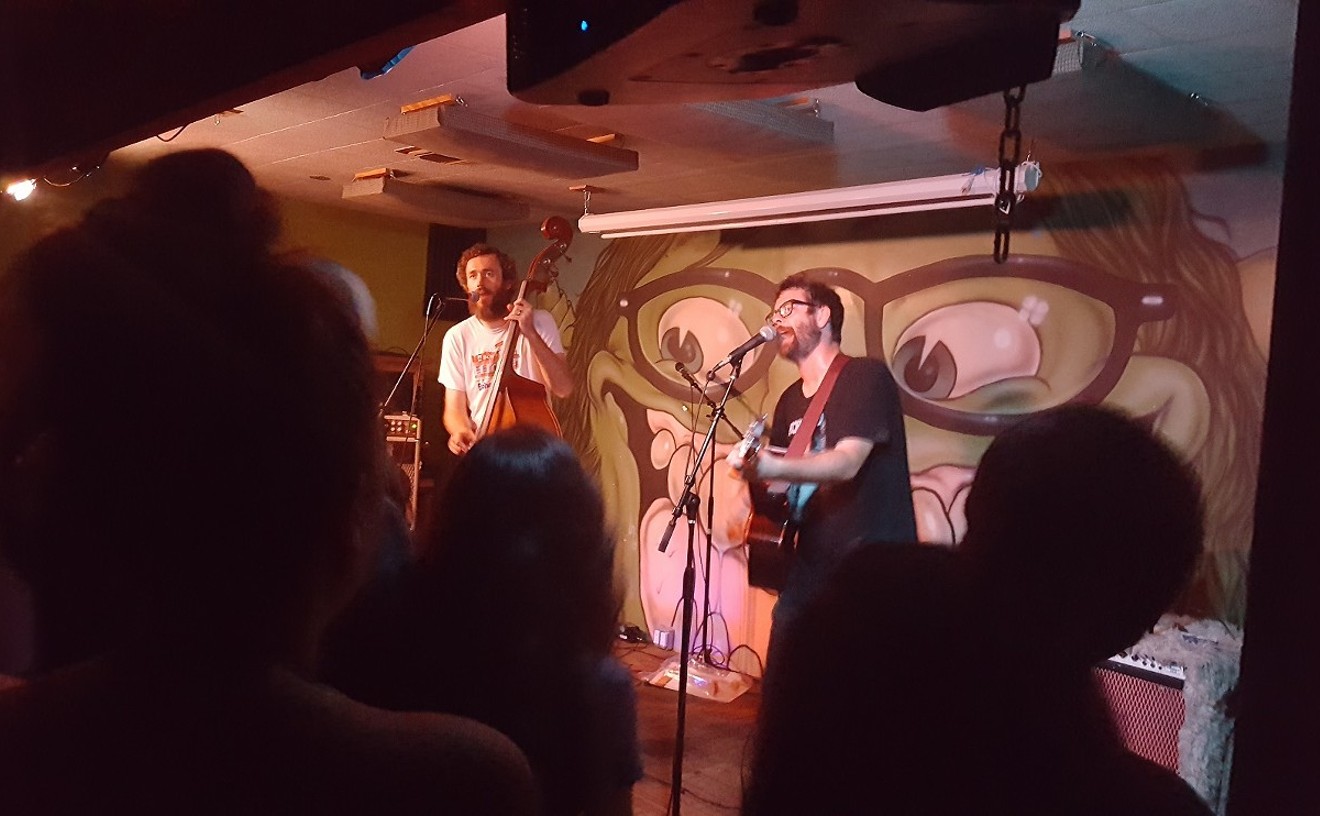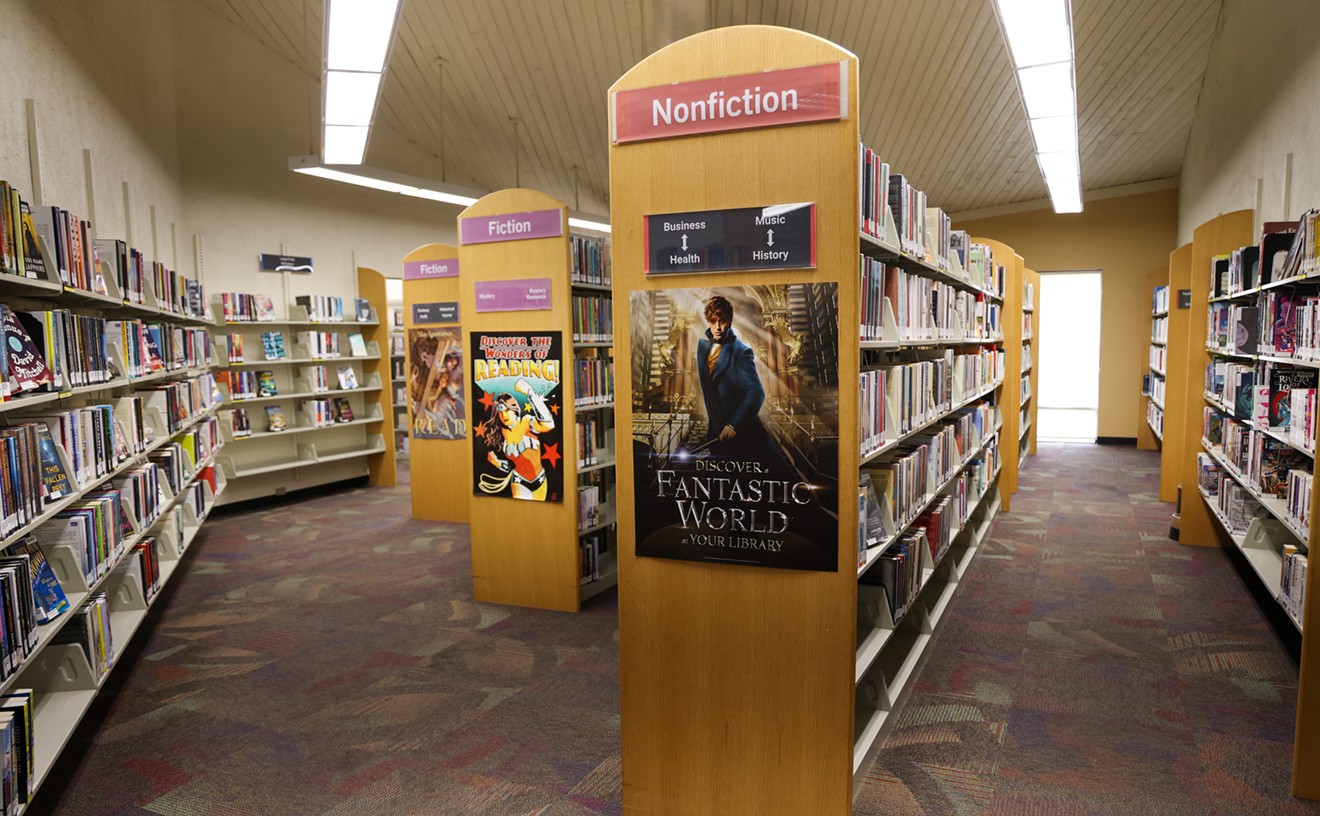But if you're up for some thought-provoking art that takes substantially more time and effort to digest than the latest story on Charles Barkley, then hie thee to Tempe.
In his most recent body of work, curated by museum director Marilyn Zeitlin, Francesc Torres takes issue with that old saying: "If it's in black and white, it must be true." Just how easy it is for governments of all political persuasions, aided by slavish media, to mold, manipulate and rewrite history--and our perception of it--is one of the strong currents running through Torres' conceptually complex work, which fills two of the museum's largest galleries. The idea that government regularly manufactures its own self-perpetuating version of history to reflect current political policies is nothing new. In his enduring novel 1984, George Orwell called these historical editing methods "Newspeak" and "Doublespeak," techniques used by his fictitious government of Oceania to control political thought and eradicate ideological heresy.
Francesc Torres is a visual and spiritual counterpart to Orwell, sharing Orwell's savage cynicism about how language and, most recently, imagery are routinely used to confuse, cover up and rearrange the true nature of what has really taken place. Torres' work also reflects an Orwellian vision of a "distopian" world--the attempted but failed social utopia always promised but never delivered by any political system past or present. In "Too Late for Goya," the central installation of the show, Torres jettisons the idea that the camera never lies and demonstrates the ease with which history can be engineered. In a dimly lighted gallery, the artist has projected gigantic video clips from what he considers the six most important historical events of the 20th century, chosen because of "their subsequent consequences and their universal historic dimensions." The images include the Russian Revolution in 1917; Hitler's rise to power in 1933; the Yalta Conference in 1945 (showing Churchill, Franklin Delano Roosevelt and Joseph Stalin), marking the end of World War II and the beginning of the Cold War; the end of colonialism as illustrated by Algeria's war of independence in 1963; and Gorbachev's rise to power in 1985, trumpeting the eventual demise of communism in the Soviet Union.
The video clips twitch at an excruciatingly slow pace, in contrast to "the brutally accelerated changes in all of mankind's history" depicted in the projections. (Torres imprinted six seconds of original footage for each event onto a videodisc; a computer extends these segments into a half-hour of playing time, producing an almost imperceptible pulsation of movement every ten seconds.)
In front of the projected images, a larger-than-life bronze statue of a chimpanzee perches on a high chair that swivels back and forth in a half-arc. The statue helplessly watches these minispasms of history, including a picture of the artist himself popping in and out of the Yalta Conference. History repeats itself, Torres appears to be saying, and, unfortunately, we are no more evolved or involved with our own destinies than that chimp in the chair. Adding to the overall impact of the installation is a color television set tuned to live CNN Headline News, replete with commercials, its audio garbled and distorted by a reverberation device. The resulting effect is of being in a large cave or echo chamber. The installation's eeriness was heightened for me as a CNN anchorperson dreamily announced the death of rock icon Frank Zappa. Zappa, known for his well-honed Duchampian sense of the absurd, would have approved of the experience, I'm sure.
"The main objective of 'Too Late for Goya' is the fusing of traditional historical painting with the electronic image," says curator Zeitlin. "The title refers to Goya's use of paintings and graphics to illustrate history. Torres does the same thing using the tools of the modern reporter, playing off the heroic and critical traditions that Goya's work embodies."
In Torres' "Newsweek Series," consisting of enormous Cibachrome triptychs of half-dissolved magazine images from Desert Storm sandwiched between insipid commercial ads, the artist illustrates what he calls "collective amnesia," an important corollary to the idea of historical revision. It's the phenomenon we've all experienced of forgetting the horrors of the past in order to justify or deal with the present. According to Torres, "It is not possible to manufacture history without the complicity of forgetfulness." Desert Storm is a perfect example of this chilling phenomenon. Who really remembers the name of the tortured POW whose face was plastered on the cover of every news magazine printed during our ultimately abortive military foray into the desert to preserve democracy? I can't, even as repeated images of his battered face stared back at me from one of the triptychs, the ink of the newsprint dissolving even further his fading memory. For that matter, who really remembers Desert Storm?
Torres' concern with ideology and politics began early on. A disenchanted Marxist (not unlike George Orwell), he was born in 1948 in Barcelona, Spain, in the shadow of the repressive fascist regime of Generalissimo Francisco Franco. Much of Torres' later work reflects this. In lieu of formal university education, the artist went to Paris, where he became involved in the May 1968 student revolt that ended in the French national strike that nearly toppled de Gaulle's administration. He stayed in Paris long enough to apprentice with French artist Piotr Kowalski, an important member of the art and technology movement of the 1960s and 70s and an early pioneer of kinetic and installation art.
In 1972, Torres emigrated to the United States, ultimately settling in New York City, where he still lives and works. He is credited with creating more video installations than any other artist in the field. Torres' list of national and international museum exhibitions encompasses major exhibitions at New York's Whitney Museum of American Art, including its 1989 and 1992 Biennial, the Museum of Modern Art and Los Angeles' Museum of Contemporary Art. One of Torres' most memorable, and perhaps controversial, installations, "Chronicle of Getting Lost," was created for the 1992 World Expo in Seville, Spain. The expo was anchored by the commemoration of the 500th anniversary of America's discovery by Christopher Columbus. To counteract, in Torres' words, its "decaffeinated celebrations," the artist filled Seville's Church of San Luis de los Franceses, an ornate, 16th-century baroque church whose richly gilded interior came courtesy of the raping and pillaging of New Spain, with 20,000 white paper ships made by schoolchildren in the area.
On the church altar, Torres replaced a reliquary containing religious relics--the teeth, finger bones and hair of saints--with a video monitor showing a Native American boy reading a 16th-century book at a table, the top of which turned into a miniature sea with three paper ships sailing toward the boy. When he noticed them, the child would blow at the ships, making them disappear; the amplified sound of his breath was broadcast throughout the church. From the monitor cascaded the small, white ships, filling the church nave like sea foam and surrounding a pensive figure sitting in one of the pews holding a paper boat in his hand. The figure was Christopher Columbus, the man who stirred up the waters of modern history forever.










